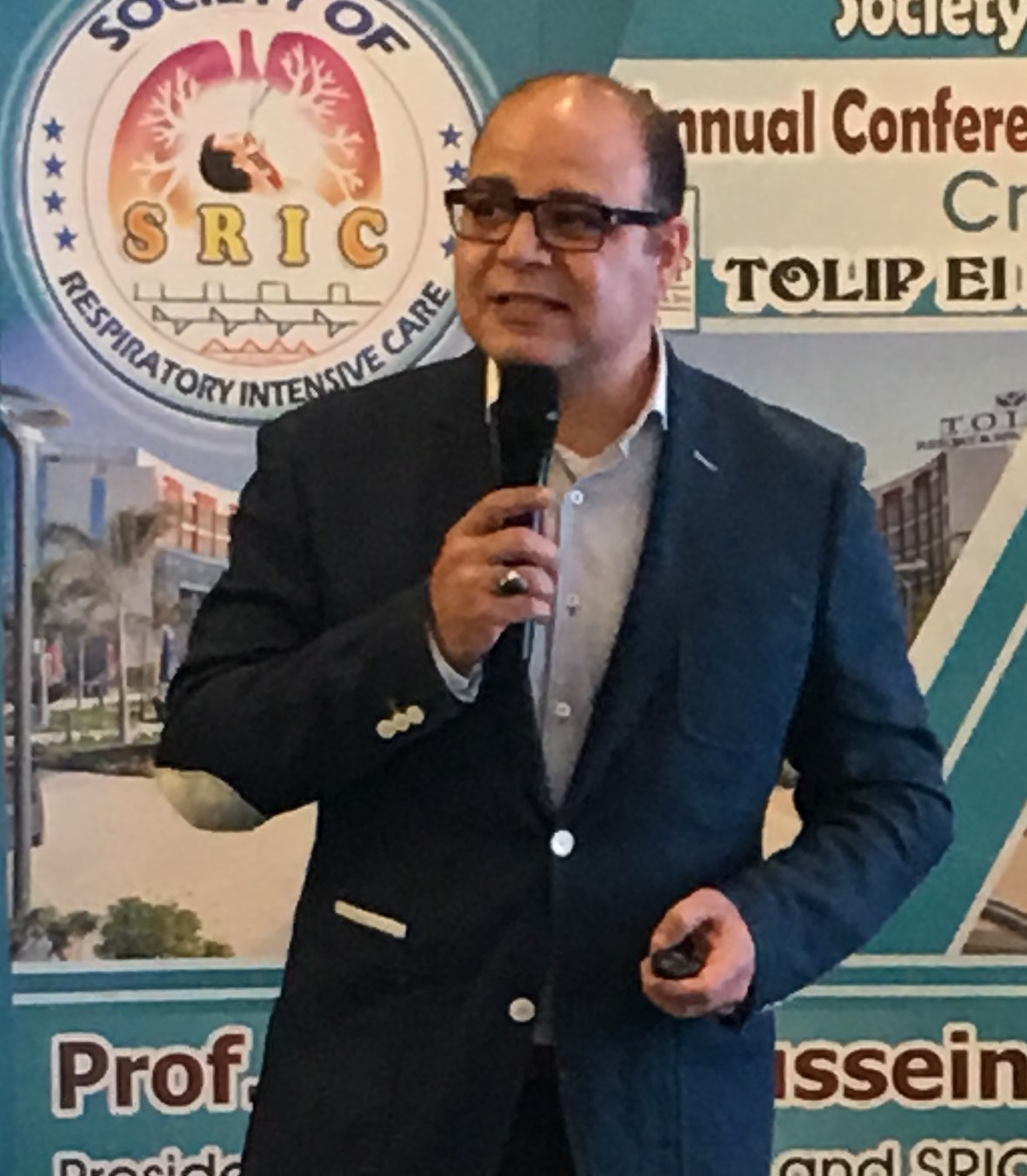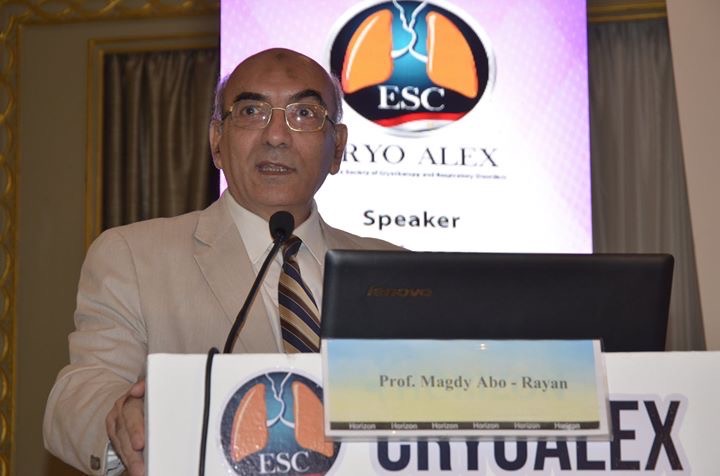
|
Study of CD305, CD26 Expression in Chronic Lymphocytic Leukemia
|
|
|
1Heba M. El-Erian, 1Mohamed K. Zahrah, 1Sahar Hazzaa, 2Atef M. Taha
|
|
|
1Clinical Pathology, 2Internal Medicine, Faculty of Medicine, Tanta University
|
|
|
hazzaasahar@yahoo.com
|
|
|
42
|
|
|
ABSTRACT:
Background: B-CLL is a heterogeneous disease with a highly variable clinical course and prognosis. Rai and Binet staging systems have been recognized as standard methods of assessing the survival and the treatment requirements in B-CLL patients. There is a need to seek out other prognostic factors in the early stage of the disease to identify stable or progressive forms of CLL that might facilitate risk-adapted treatment strategies. CD26 is a multifunctional type II cell surface glycoprotein that is widely expressed by many cells. LAIR1 (CD305) is a transmembrane glycoprotein acting as inhibitory receptor has been recently demonstrated in patients with CLL.
Aim of the Work: Studying the role of CD305, CD26 expression in chronic lymphocytic leukemia and their correlation with CD38 and ZAP 70 expression.
Subjects and Methods: This study was conducted on 50 newly diagnosed CLL cases from Internal Medicine Department, Tanta University Hospital and 20 healthy subjects as a control group.
Results: Higher expression of ZAP 70, CD38, CD26, lower expression of CD305 is associated with more advanced staging. A negative correlation between CD305 expression and TLC, ALC, LDH, CD26, CD38 and ZAP 70 expression and a positive correlation with Hb level and platelet count. Where, positive correlation between CD26 expression and previous parameters and a negative correlation with Hb level, platelet count and CD305 expression. There was a significant longer overall survival and disease free survival in patient with high CD 305 expression and also in low CD 26 expression.
Conclusions: CD26 and CD305 together with CD38 and ZAP 70 represent an important adverse prognostic markers, their expression should be routinely investigated for a better prognostic assessment of CLL patients and showed be taken in consideration in designing further therapeutic strategies based on patient specific risk factors.
Key words: CD305 Expression, CD26 Expression, Chronic Lymphocytic Leukemia.
|
|

|
Household air pollution (HAP)
|
|
|
Ahmed Shawky
|
|
|
Ahmed Sh. Mohamed , phd, MD
|
|
|
ashawky_72@yahoo.com
|
|
|
88
|
|
|
Household air pollution (HAP) also called Indoor air pollution (IAP) in developing countries is a major environmental and public health challenge. Around 3 billion people cook using polluting open fires or simple stoves fueled by kerosene, biomass (wood, animal dung and crop waste) and coal. Each year, close to 4 million people die prematurely from illness attributable to household air pollution from inefficient cooking practices using polluting stoves paired with solid fuels and kerosene and simple wick lamps. Household air pollution is in many ways comparable to occupational air pollution. According to WHO there is consistent evidence that exposure to household air pollution is a major risk factor leading to acute lower respiratory infections in children under five, and ischemic heart disease (IHD), stroke, chronic obstructive pulmonary disease (COPD) and lung cancer in adults. More generally, small particulate matter and other pollutants in indoor smoke inflame the airways and lungs, impairing immune response and reducing the oxygen-carrying capacity of the blood.
|
|

|
Imaging in occupational lung diseases Prof Gamal Agamy.
|
|
|
Gamal Agamy.
|
|
|
Gamal agmy , PhD, MD
|
|
|
gamalagmy135@gmail.com
|
|
|
89
|
|
|
Occupational lung disease comprises a wide variety of disorders caused by the inhalation or ingestion of dust particles or noxious chemicals. The most common acquired occupational lung diseases include occupational asthma, bronchitis, bronchiolitis, hypersensitivity pneumonitis, acute toxic inhalant syndromes, pneumoconioses, and tumors. Most of these disorders produce diffuse lung disease. Some occupational lung diseases have characteristic radiologic features suggesting the correct diagnosis, whereas in others, a multidisciplinary approach with focus on occupational exposure history, clinical features, and radiologic findings is essential to proper diagnosis. Although many of the disorders can be detected at chest radiography, high-resolution computed tomography and other imaging modalities shown to be superior to chest radiography in depicting parenchymal, airway, and pleural abnormalities. Increasing use of computed tomography has demonstrated that specific occupational exposures can result in a variety of patterns of lung injury.The challenge of accurately identifying an occupational exposure as the cause of lung disease demands a team approach, requiring integration of imaging features with exposure type, time course, and severity.
|
|

|
Acute inhalation injury
|
|
|
Mohamed Mostafa Metwaly
|
|
|
Mohamed Mostafa ,PhD, MD . prof. Assuit university
|
|
|
Melhadi@yahoo.com
|
|
|
90
|
|
|
Inhalation injury remains a significant cause of morbidity and mortality in thermally injured patients. Inhaled substances may cause injury in pulmonary epithelium at various levels of respiratory tract, leading to variable health effect ranging from simple symptoms to severe disease. Acute inhalation injury (AII) is not uncommon condition. There are certain high risk groups but AII may occur at various places including home or workplace. Environmental exposure is also possible. Inhaled substances may directly injure the pulmonary epithelium at various levels of the respiratory tract, leading to a wide range of disorders from tracheitis and bronchiolitis to pulmonary edema. They may also be absorbed, resulting in systemic toxicity. In addition to individual susceptibility, the characteristics of inhaled substances such as water solubility, size of substances and chemical properties may affect disease severity as well as its location. Although AII cases may recover in a few days but AII may cause long-term complications, even death.
|
|

|
Does environmental pollution affect tuberculosis T.B?
|
|
|
DR : Wagdi Amin
|
|
|
DR: Wagdy Amin , NTP Egypt , Ministry of Health and Population
|
|
|
drwagdy@yahoo.com
|
|
|
91
|
|
|
Pollution is affecting everyone in developed and developing countries and continues to pose a major threat to human health, worldwide. The risk of TB associated with three important sources of exposure: tobacco smoking, environmental tobacco smoke, and indoor burning of solid fuels. Significant association was found between exposure to combustion-derived air pollution and TB development. Air pollution affects resistance to tuberculosis infection via effects on airway resistance, epithelial permeability, and macrophage function. Long-term exposure to fine particles less than 2.5 micrometers in diameter (PM2.5) and CO was positively associated with TB development , as studies suggest a specific role for PM2.5. Moreover, PM-associated transition metals, e.g., iron, are thought to produce oxidative stress in lung, and altered host defenses. Amount of iron in the lung has also been hypothesized to adversely affect the progression of TB. also studies founded that significantly increased risk of TB primarily occurring after 2 to 3 months of air pollution exposure.
|
|

|
Environmental electronic vape exposure.
|
|
|
Dr: Esam Elmoghazy
|
|
|
Chairman of theassociation against Smoking, TB and Lung diseases Cairo Egypt
|
|
|
elmoghazy@yahoo.com
|
|
|
92
|
|
|
Electronic cigarettes (e-cigs) were introduced into the market in 2006 and their technological features have evolved substantially over time. Currently, there are four different generations of e-cigs that are broadly considered less harmful than use of combusted tobacco products. Each stage of e-cigarette product lifecycle, including mining, manufacturing, using and disposing, could pose a potential environmental harm. Health risks associated to e-cig smoking depends firstly on safety of liquid formulation mix and of its single chemical components and several types of accidents can happen as well, including those due to explosion of the e-cigarette battery. The basic components of e-liquids are propylene glycol and vegetable glycerin, to which nicotine and flavorings are added in different concentrations. Environmental electronic vape (EEV) exposure to PM does occur during the use of all available e-cigs models up to the most recent fourth generation devices, also passive exposure to particulate matter (PM) occurs when using e-cigs. PM is a known risk factor for different diseases including pulmonary, cardiovascular diseases or cancers, independently from its composition. Adverse health effects have been mainly linked to the PM10 size fraction, and to fractions with lower aerodynamic diameters.
|
|

|
Air pollution adds to sleep disorders
|
|
|
Ramadan Nafae
|
|
|
Ramadan Nafae ,PhD, MD , prof. zagazig university
|
|
|
rnafae@hotmail.com
|
|
|
93
|
|
|
Air pollution increased risk of sleep-disordered breathing (SDB), a group of disorders including sleep apnea. SDB and air pollution have each been linked to increased risk of autonomic dysfunction, pulmonary and systemic inflammation, elevated blood pressure, arrhythmias, myocardial infarction, and cardiovascular mortality. Individuals with highest levels of NO2 over five years had an almost 60% increased likelihood of having low sleep efficiency compared to those with lowest NO2 levels ,also highest exposures to small particulates (PM2.5) had a nearly 50% increased likelihood of having low sleep efficiency. Increases in SDB, as measured by both respiratory disturbance index and overnight hypoxemic index, decreases in percentage of sleep efficiency, are associated with increasing levels of daily particulate matter in summer months. Air pollution effects needs to take into account temperature, which may have independent effects on respiratory outcomes, as increases in respiratory disturbance index are associated with increases in short-term temperature. Therefore, reduction in air pollution exposure may decrease severity of SDB and nocturnal hypoxemia and may improve cardiac risk.
|
|

|
Outdoor pollution contributes to lung health.
|
|
|
Prof: Mohamed El-Batanony
|
|
|
Prof MD PhD
|
|
|
madoelbatanony@hotmail.com
|
|
|
132
|
|
|
Ambient air pollution is a major global public health problem. this health problem can affecting both developing and developed countries. Air pollution continues to be a major public health . we can say that this problem concerns affecting nine out of ten individuals living in urban areas worldwide. Exposure to air pollution is the ninth leading risk factor for cardiopulmonary mortality. also Air pollution is an important contributor to respiratory complications, especially for developing countries who use biomass fuels and coal for heating and cooking in the home. Air pollution exposure is a corner stone cause that can trigger new cases of asthma, exacerbate (worsen) a previously-existing respiratory illness, and provoke development or progression of chronic illnesses including lung cancer, chronic obstructive pulmonary disease, and emphysema. moreover Air pollutants also negatively and significantly harm lung development. air pollution indeed creating an additional risk factor for developing lung diseases later in life.
|
|

|
Impact of air quality on lung health a myth or a truth?
|
|
|
Ayman Abdelzaher
|
|
|
Prof . MD . PhD
|
|
|
aymanabdelzaher@yahoo.com
|
|
|
133
|
|
|
Air pollution may be an important environmental risk factor with global, public health implications. Epidemiological studies suggest that significant exposure to air pollutants appears to be associated with respiratory exacerbations. There’s good evidence that outdoor air pollution contributes to lung cancer, and it’s possible that long-term exposure to air pollution is linked to the development of asthma. Particulate matter with an aerodynamic diameter less than 2.5 μm (PM2.5) and O3 are amongst the most studied air pollutants of health concern. It seems as if the size of particles is directly linked to their potential for causing health problems. Particles less than 10 μm in diameter can get deeper into the lungs and some may even get into the bloodstream, it should be noted that specific changes in climate appears to have a negative impact on overall air quality with substantial increase in respiratory morbidity and mortality of patients with chronic lung conditions .
|
|

|
It’s not IPF, It’s HSP
|
|
|
Prof Maha Ghanem
|
|
|
Prof MD PhD
|
|
|
mahaghanem@yahoo.com
|
|
|
134
|
|
|
Hypersensitivity pneumonitis (HSP) is an interstitial lung disease in genetically predisposed individuals caused by exaggerated immune response to chronic inhalation of a variety of antigens in environment. HSP is difficult to evaluate given that disease is oftentimes unrecognized or misdiagnosed and exposure conditions vary in intensity of exposure (usually low) and from place to place. Patients seldom relate their symptoms to environmental exposure and onset of symptoms is gradual. Physicians often misdiagnose disease for another interstitial lung disease such as idiopatic pulmonary fibrosis IPF/UIP. So HSP is an important mimicker of IPF. This can be explained by, long-term inflammation, HSP with progressive fibrosis and bronchiolitis obliterans in late chronic stages, histopathology may be similar to UIP or fibrotic NSIP pattern. HSP/CHP its bronchovascular distribution makes it uniquely different from UIP. Air trapping is also important in making correct diagnosis of CHP (rarely seen with UIP), while Emphysema is frequently seen with UIP but rarely with CHP. A careful history regarding occupational/domestic environment and hobbies in every patient with insidious respiratory symptoms is crucial in diagnosis.
|
|

|
Pollution and lung cancer
|
|
|
Prof: Waleed Elsorogy
|
|
|
Prof MD PhD
|
|
|
waleedsorogy@yahoo.com
|
|
|
135
|
|
|
Lung cancer accounts for 1.2 million deaths yearly worldwide, exceeding mortality from any other cancer in the developed countries. The vast majority are caused by tobacco smoking, but environmental causes of cancer, including air pollution, have long been a concern also. Lung cancer attributable to air pollution may occur among both smokers and non-smokers. A substantial number of epidemiological studies suggested that outdoor air pollution and in particular respirable particulate matter (PM10) and fine particulate matter (PM2.5) are associated with an increased risk of lung cancer. Urban air contains known and suspected human carcinogens such as benzo[α]pyrene, benzene, and 1,3-butadiene, together with carbon-based particles onto which carcinogens may be adsorbed, oxidants such as ozone and nitrogen dioxide, and oxides of Sulphur and Nitrogen in particle form. Increased lung cancer has also been reported among workers occupationally exposed to components of urban air pollution such as polycyclic aromatic hydrocarbons and diesel exhaust. It was reported that each 10 μg/m3 increment of fine particles (PM2.5) was associated with an 8–14% increase in lung cancer.
|
|

|
Air pollution speeds up aging of lung
|
|
|
Prof Hossam Hosney
|
|
|
Prof MD PhD cairo university
|
|
|
hosam-hosney@yahoo.com
|
|
|
136
|
|
|
The effects of air pollution on respiratory function are well documented, Long-term exposure to polluted air can have permanent health effects such as: Accelerated aging of the lungs, Loss of lung capacity, decreased lung function, and shortened life span. New studies is adding more evidence that air pollution increases risk of development of diseases such as asthma, bronchitis, emphysema, and possibly cancer. Each additional 5 micrograms per cubic meter of particle pollution a person was exposed to on average annually, the lungs showed an equivalent of two years of aging and a real reduction in lung function. Exposure to Fine Particulate Matter (PM2.5) and Nitrogen Dioxide (NO2) can age lungs by up to 2 years. Air pollution had approximately twice the impact on lung function decline and three times increased COPD risk on lower-income participants compared to higher-income participants who had same air pollution exposure. Most susceptible population to severe health problems from air pollution are: heart disease, lung diseases as asthma or COPD, Pregnant women, Outdoor workers and the elderly, Children under age 14, Athletes who exercise vigorously outdoors.
|
|

|
Air pollution and OSA
|
|
|
Prof Magdy Abo Rayan
|
|
|
Prof MD PhD alexandria university
|
|
|
magdyaborayan@yahoo.com
|
|
|
137
|
|
|
sleep apnea is a potentially serious sleep disorder in which breathing repeatedly stops and starts during sleep. Obstructive sleep apnea is the more common type. It occurs when the throat closes and blocks the flow of air.Epidemiological studies may provide evidence of relationships between chronic air pollution exposure and sleep apnea. Air pollution may influence sleep through airway inflammation or autonomic nervous system pathway alterations. Air pollution levels may contribute to OSA risk and severity through impair pulmonary immune defense, alter normal airway clearance by upper airway irritation, injury and inflammation of mucosa, edema and subsequent narrowing. Air pollution exposure. The proximal upper airways such as the naso-pharynx, may respond similarly with inflammation and edema. Association of short-term PM10 with an elevation in apnea hypopnea index (AHI) and reduced sleep efficiency particularly in the summer. Greater air pollution (NO2 and PM2.5) exposure was also associated with greater AHI and oxygen desaturation index, with a similar seasonal component of spring and winter. Moreover, elevated short-term ozone and temperature were associated with a higher AHI.
|
|
.pdf)
|
Environmental Social Detachment and Internet Dependence among Undergraduate College students at Tanta University , Egypt
|
|
|
Prof.Dr.Asmaa Abdel Rheim , Dr. Mira Maged Abu-Elenin
|
|
|
Community Medicine Department,Faculty of Medicine,Tanta University
|
|
|
mira.maged@hotmail.com
|
|
|
223
|
|
|
Background:
Internet became inseparable part of everyday life. Its use poses merits and threats, accusing detachment from social environment; increasing social isolation, qualitative and quantitative lack of social interactions and coping skills. Youth grown up with smart phones ,they are more susceptible to these consequences. This study has worked on the relationship between internet dependence and social environment detachment among undergraduate college students at Tanta University.
Methods:
This cross sectional study targeted undergraduate college students in Tanta University during academic years 2018,2019. Participants were recruited from 7 medical and theoretical colleges through a stratified multistage random technique. Sociodemographic and academic data were collected through a structured questionnaire. Social environment detachment level was assessed by revised loneliness scale. Internet addiction test was used to determine the level of internet dependence. Spss software program v.21 was used for statistical data analysis.
Results:
The study included 1082 undergraduate students, 68% (n=736) of them were females. Medical colleges students represented 52% (n=562) and those from theoretical colleges were 48% (n=520). About 35% (n=382) of them suffered from severe degree of social isolation and 82% were reported to use internet significantly above average. Higher parents educational level and living with their families were significantly associated with increased degree of internet dependence (p=0.004.,0.04 respectively). Students with medical background significantly recorded higher scores for of internet addiction test and more sever degree of social detachment than their counterparts (p= 0.01,0.001,respectively). The students who depend on internet more than average were of more severe degree of social detachment (p >0.0001).
Conclusions:
Youth are extreme users of internet because they are attracted to cyberspace as a fascinating alternative for their real life. This may lead to lack of healthy social environment and negatively.Therefore it is necessary to unveil threats of internet dependence and promote social skills among college students.
|
|

|
Patient safety culture among health care workers in Tanta University Hospitals, Egypt
|
|
|
Sanaa Abd El-fatah Mostafa Abdo & Asmaa Abd Elraheem Atallah
|
|
|
Public Health and Community Medicine, Faculty of Medicine, Tanta University
|
|
|
sanaaabdo15@gmail.com
|
|
|
225
|
|
|
Background: Patient safety has become a priority in healthcare system. It minimizes the incidence, impact of, and maximizes recovery from adverse events. Objectives: To assess patient safety culture among health care workers (HCWs) in Tanta University Hospitals. Subjects and methods: a cross-sectional study was conducted over a period of 1 year on 949 HCWs in Tanta University Hospitals using Hospital Survey On Patient Safety Culture of AHRQ. Results: Physicians had the lowest mean % positive responses in most dimensions of safety culture. Physicians were most likely to report events in the last 12 months; from 1-5 events (30.3%) and more than 5 events (10.1%). Males reported more events than females (10.1%, and 3.1%, respectively). Surgical departments were most likely to report events than medical ones (6.0%, and 3.3%). HCWs with less than 5-year experience reported more events than others (1-5 events; 24.8%, and > 5 events; 5.7%). Overall, patient safety grade was accepted to 47.7 % of participants. Conclusion: Many dimensions of safety culture were recognized as weak or areas of potential improvement thus comprehensive education and training on patient safety, its concepts, tools, and implementation for all HCWs are recommended to facilitate change in patient safety culture.
|
|

|
Brain drain: Why physicians want to leave country?
|
|
|
Ibrahim Kabbash, Sanaa Abdou, Hana Zaied, Rania El-Sallamy
|
|
|
Faculty of Medicine - Tanta Univeristy
|
|
|
ibrahim.kabbash@med.tanta.edu.eg
|
|
|
233
|
|
|
Background: Migration of healthcare workers is increasing worldwide especially from less developed countries to developed ones. The driving forces for immigration of healthcare workers are the inadequate work conditions, or the reduced employment chances in home country, low salaries and motivation to get better chance of training push many of them to search for long term employment abroad.
Objective: to assess prevalence of Egyptian physicians planning to migrate and contributing factors to physicians\ migration.
Methods: A cross sectional study was carried in Tanta University Faculty of Medicine including clinical stage students and junior staff physicians. Data were collected using electronic Google forum questionnaire to determine socio-demographic data, working conditions, physicians planning for immigration and their drive for migrations.
Results: A total number of 437 participants were included. Among participants, 89.9% reported that physicians’ salaries is not enough and 49.7% were forced to join private work to improve their income. Long working hours results in family conflicts among 52.4% of participants. Those planning to migrate represented 86.7% among undergraduate students and 70.9% among junior graduates. The main drives for migration were absence of appreciation of physicians by health authority, patients and their relatives. Participants reported suffering from verbal violence (79.7%) and physical violence (19.6%). They also reported lack of facilities at health premises to perform their work efficiently (74.3%),
Conclusion: the majority of physicians are frustrated form working conditions and have the desire to migrate. Policy makers in Egypt need to implement a comprehensive national health workforce plan to improve working conditions and positively with physician migration to avoid brain drain and potential negative effects on health care.
|
|

|
Work family conflict among administrative females working in Tanta University
|
|
|
Rania El-Sallamy, Hanaa Zaied, Ibrahim Kabbash, Sanaa Abdou
|
|
|
Faculty of Medicine - Tanta University
|
|
|
rania.elsalamy@gmail.com
|
|
|
234
|
|
|
Background: Worldwide women actively entered in the labor market either to enhance their personal career or due to the economy pressures to support their families. But, women still maintain primary responsibility for childcare, housework and may be care of the elderly parents. Work family conflicts (WFC) start to appear when performance in one role creates an inability to perform the other role adequately.
Objective: to investigate work-family conflict among female university administration employees.
Methods: A cross sectional study was carried among females working at five randomly selected faculties of Tanta University. A total of 443 female workers were recruited. Data were collected using a self-administered questionnaire including personal characteristics, job characteristics, home responsibilities, negative and positive spillover effect of work on family and of family on work. Results: Participants’ mean age was 39.8±10.2 years. Nearly one third (32.1%) reported low positive work circumstances while 10.2% reported high negative work circumstances. Of them 29.4%, had poor family spillover on work. Poor spillover of work on family was reported by 18.6%.
Conclusion: a considerable proportion of female workers had difficulty set balance between work and family responsibilities. They need help to set such balance in order to perform effectively and efficiently in the workplace.
|
|

|
Digital eye strain: prevalence, and associated factors among information technology professionals in Tanta University. Egypt
|
|
|
Hanaa A. Zayed, Shimaa M. Saied, Eman Ali Younis , Salwa A.Atlam
|
|
|
Faculty of Medicine, Tanta University
|
|
|
hanazayed55@yahoo.com
|
|
|
235
|
|
|
Background: Digital eye strain (DES), also known as computer vision syndrome, encompasses a range of ocular and visual symptoms, and estimates suggest its prevalence may be 50% or more among computer users.
Objectives: To identify the prevalence of DES and to study some personal, ergonomic workstation and micro environmental risk factors of DES among information technology (IT) professionals in Tanta University.
Materials and Methods: Self-administered Questionnaire was used for data collection regarding the demography, duration of computer use, working distance from screen, level of top of screen from eye level, use of antiglare screen, screen resolution adjustment and taking breaks during computer use. Computer vision syndrome questionnaire (CVS-Q) was used to measure Ocular and visual symptoms related to exposure to computers in the workplace.
Results: A total of 108 subjects with a mean age of 34.296± 8.5972 years were included. The majority of participants (81.5%) had computer vision syndrome (CVS). The most common reported symptoms in descending order were headache, Burning, Feeling that sight is worsening, Blurred vision and eye dryness. Moderate to severe symptoms were reported in the majority of study subjects especially those who use computer for long hours. Position of screen above the eye level, low relative humidity, use of air conditioning, windy environment and air pollution were found to aggravate ocular symptoms.
Conclusion: Continuous use of computers for long hours is found to have severe problems of vision especially in those who are using computers for a long duration in unadjusted workstation.
Key words: Computer vision syndrome; information technology
professionals; Digital eye strain.
|
|

|
Assessment of Health Status and Safety Measures for Workers in Phosphate Fertilizers Industry in Kafr El Zayat City,Gharbia Governerate, Egypt
|
|
|
Dalia Mohamed Abd Elmagid, Nadira M. Hassan, Nihal S. Shehab, Hanaa A.Zayed
|
|
|
Public Health and Community Medicine Department- Faculty of Medicine Tanta University, Egypt
|
|
|
Daliammegid@gmail.com
|
|
|
237
|
|
|
Background: Phosphate fertilizers industry is one of the most environmental polluting industries in Egypt. Many environmental and health hazards occur. Objectives: To assess the workers' health status, health hazards and the application of safety measures in in Kafr El-Zayat factory for Single Super Phosphate fertilizers and Commercial Sulfuric Acid.
Subjects & methods: A cross sectional study that included all workers (180 workers) in the production sector in Kafr El-Zayat factory which is affiliated to the Egyptian Financial and Industrial Company (EFIC). The study tools were interview questionnaire & environmental inspection checklist. Spiro metric measurements for workers and environmental monitoring of total dust, sulfur dioxide, hydrogen fluoride and noise were done and recorded.
Results: A total of 180 exposed workers with a mean age of 47. 34±9.23 years were included. Rhinitis (49.3%), cough (38.9%) and expectoration (38.3%) were the most frequent respiratory manifestations. Recurrent conjunctivitis (55.6%), difficulty of hearing (30%), Contact dermatitis (15%), and Gum & teeth disorders (14.4%) were commonly reported. Fifty one workers (28.33%) showed abnormal Spiro metric measurements. The mean percentage for applied safety measures was 44.4%. Environmental monitoring revealed higher levels of hydrogen fluoride, sulfur dioxide and total dust in the work environment.
Conclusion & recommendations: There was a defect in safety measures application that was reflected on workers' health and the environment. So, strict supervision and penalty for application of standard safety measures are essential.
|
|

|
Health Hazards and Safety Measures among Workers in Tanta flax and Oil Company
|
|
|
Dr. Asmaa Ali Elfeky1 , prof. dr. ibrahim ali kabbash2 and Assist. Prof. rania mostafa el sallamy 1
|
|
|
1:occupational and environmental medicine , 2: public heath and community medicine
|
|
|
moslima189@yahoo.com
|
|
|
241
|
|
|
Background: Flax industry affects the health of exposed workers especially in developing countries like Egypt with lack of appropriate safety measures. Aim: the aim of the study was to identify the health hazards among workers in flax and Oil Company and to assess the applied safety measures. Material and methods: A cross sectional study conducted in Tanta flax and Oil Company. The sample size was 369 workers. An Interview questionnaire was filled to assess the health status and a clinical medical examination was done to the workers. A check list from occupational safety and health administration (OSHA) standards was filled to check safety measures in work place environment. Results: Respiratory manifestations were found in 65% of the examined workers in flax manufacturing departments while allergic manifestation was more obvious in formaldehyde factory. The safety measures were inadequate in flax manufacturing departments and to somewhat sufficient in formaldehyde factory. Conclusions: Most of the exposed workers had in adequate health status due to lack of standard safety measures. Recommendations: periodic medical examination should be done regularly with investigation of pulmonary functions to the exposed workers with a high level of safety measures in the work environment.
|
|

|
Towards safe environment: syringe disposal among diabetic patients attending Internal Medicine outpatient clinic department, Tanta University
|
|
|
Nadira M. Hassan1*, Eman Yunes1 , Zinab El Khamry 2, , Safynaz S. Shalby1
|
|
|
1Community Medicine Department, Faculty of Medicine, Tanta University, Tanta, Egypt 2Occupational Medicine Department, Faculty of Medicine, Tanta University, Tanta, Egypt
|
|
|
drnadiram@yahoo.com
|
|
|
247
|
|
|
Background: In Egypt, 8.2 million adult diabetics using almost 16 million insulin syringes daily. Unsafe disposal of theses syringes will result in many environmental hazards at individual and community level. Objectives: To assess knowledge, attitude & practice of diabetic patients towards safe disposal of insulin syringes. Subjects & methods: cross sectional study including 429 Diabetic patients who receive insulin injections at outpatient clinic of internal Medicine department, Tanta University Hospital during a period of two months. Their Knowledge, attitude and practice of insulin syringe disposal was assessed using a predesigned questionnaire and a health education session was given to help them for safe disposal. Results: mean age of studied group was 54.48±11.02 years, 56% of them were females, 71.6% were rural, 78.3% were married, most of them were illiterate (48%), unemployed (46.2%) and 45% their income was not enough. Mean duration of diabetes was 11.93±6.96 years and insulin injection 8.18± 5.95 years. Only 40% were had idea on safe disposal of insulin syringe, the first source of knowledge (46.9%) was nurse or doctor. Although, 50% of them considered safe disposal important only 54% don’t know hazards of unsafe disposal. As regards, their practice; 67% used the syringe twice, 85.5% use syringe and 14.5% use pens, 50.4% take injection by themselves, 86.5% dispose at household collection bin, about two thirds reuse the syringe and 63.21% throw it at the nearest garbage bin when take the injection outside home. Conclusion & recommendations: vast majority of studied diabetic patients don’t use and/or dispose syringe safely and a health education program for this group of population is mandatory to get safe environment for the community.
|
|

|
Assessment of Health Care Workers’ Knowledge and Confidence in Personal Protective Equipment in Tanta Fever Hospital in Egypt.
|
|
|
Asmaa Omar Atalla1, Hanaa A.Zayed 2, Noha M.Elghazally1
|
|
|
(1) Public Health and Community Medicine Dept., Faculty of Medicine, Tanta University (2) Industrial medicine and occupational health, Public Health and Community Medicine Department.
|
|
|
nohaelghazally1@gmail.com
|
|
|
250
|
|
|
Introduction: Healthcare workers (HCW) are at increased risk of infection while dealing with patients. Usage of personal protective equipment (PPE) has been shown to lower infection rates among HCW and also among patients. Aim of work: To study usage of personal protective equipment (PPE) among groups of HCWs (doctors, nurses, pharmacist, technician and workers), and to assess the effect of HCWs’ knowledge regarding personal infection control practices on the degree of confidence in PPE. Methods: A cross sectional study using self-administered validated questionnaire was distributed at Tanta Fever Hospital; including 151 physicians, 116 pharmacist, 121 nurses, 85 technician and 65 workers. Participants answered a questionnaire which included items on socio-demographic and occupational characteristics, questions on practice, knowledge and confidence of health care workers regarding the usage of personal protective equipments . Results : Confidence in PPE was significantly higher among physicians (37.6%), followed with 23.6% of nurses, 18.8% of pharmacist, 12% of technician and 8.0% among workers (P=0.000). Significant differences were found between the tested knowledge among HCW (P=0.002). High levels of tested PPE knowledge were significantly associated with PPE confidence and was one of predictors of high confidence in PPE in the regression model. Conclusion: Increasing the awareness of health care workers about the importance of adherence to usage of PPE is very important may help increase PPE usage and reduce absenteeism.
|
|

|
Work environment related violence: Impact on job performance and coping strategies among physicians in an Egyptian city
|
|
|
Ehab A. Abo Ali(1), Hanaa A. Zayed(2) and Salwa A. Atlam(1)
|
|
|
(1) Public Health and Community Medicine Dept., Faculty of Medicine, Tanta University (2) Industrial Medicine and occupational Health, Public Health and Community Medicine Dept., Faculty of Medicine, Tanta University
|
|
|
ehababoaly73@yahoo.com
|
|
|
252
|
|
|
Background: Workplace violence, as an occupational hazard in the healthcare setting, can lead to a variety of adverse consequences for the victims, including physical and psychological consequences. Additionally, it leads to job strain, job dissatisfaction and job turnover of health workers. Many studies had proven that workplace violence influences employee’s work status, like job performance. Aim: The present study aimed to study work environment related violence, its impact on job performance and coping strategies carried out by physicians in Tanta city, Egypt. Subjects and methods: This study was carried out in some hospitals of Tanta city, Egypt through a period of two months; a cross-sectional comparative study recruited 422 physicians using random cluster sampling technique. For every participant, personal and occupational data, workplace violence scale, job performance scale and coping strategies against workplace violence were self-administered. Results: Out of study participants, 79.4% reported that they feel unsafe at work. Also, 56.4% have been exposed to work environment related violence. The majority of them (85.8%) stated that there was inadequate measures for their protection while working. There was a negative correlation between job performance and work related violence. Although, there were many coping strategies adopted at the individual and administrative levels against work related violence, this work problem still needs multidisciplinary approach and support in the community.
|
|

|
Environmental Attitudes and Behaviours among Tanta University Students
|
|
|
Shimaa M. Saied1, *, Moeness M. Al-Shishtawy1, Hanaa A. Zayed1
|
|
|
1Public Health & Community Medicine Department, Faculty of Medicine, Tanta University, Tanta, Egypt
|
|
|
dr.shimaasaied@gmail.com
|
|
|
265
|
|
|
Background: Environmental degradation is an extremely important issue that requires urgent intervention. Education is essential in contributing to students’ awareness of environmental issues. Human behaviour is crucial in most environmental problems; therefore, the promotion of pro-environmental behaviour is an important way towards environmental sustainability. Objective: To assess environmental attitudes & behaviours among Tanta university students. Methods: A cross-sectional study was conducted among Tanta University undergraduate students` in faculties of Medicine, Pharmacy and Dentistry. A self-administered valid and reliable questionnaire was used for data collection including Socio-demographic data, environmental attitudes` items, environmental behaviours` items and questions regarding environmental training and source of information. Results: 920 students (295 male and 625 female) were recruited, students’ mean age was 20.3±1.1 years. Only 9.7% of the participants received previous environmental training. The majority of participants (97.9%) had positive environmental attitudes, while 86.4% had favourable environmental behaviours. The main sources of environmental information were social media and web sites (82.1% & 64.2%, respectively). Conclusion: Students showed somewhat unfavourable environmental behaviours in certain aspects, so the is a need to encourage environmental behaviour in university settings via training and supporting pro-environmental actions.
|
|

|
Work environment characteristics: as determinants of Work to family conflict among administrative female employees in Tanta University
|
|
|
Hanaa A. Zayed1, Ibrahim Kabbash2, Sanaa Abdou2, Rania El-Sallamy1
|
|
|
(2) Public Health and Community Medicine Department, Faculty of Medicine, Tanta University
|
|
|
hanazayed55@yahoo.com
|
|
|
268
|
|
|
Background: Positive work practice environment is the corner stone for control and relieving of work to family conflict (WFC).
Objective: to investigate work environment characteristics as determinants of work to family conflict among administrative female employees in Tanta University.
Methods: A cross sectional study was carried among females working at five randomly selected faculties of Tanta University. A total of 443 female workers were recruited. Data were collected using a self-administered questionnaire including personal characteristics, job and work environment characteristics, home responsibilities, negative and positive spillover effect of work on family and of family on work.
Results: Participants’ mean age was 39.8±10.2 years. Nearly one third (32.1%) reported low positive work environment while 10.2% reported high negative work environment. Of them 29.4%, had poor family spillover on work. Poor spillover of work on family was reported by 18.6%.
Conclusion: Positive work practice environment is a significant determinant to prevent and control work to family conflict.
|
|

|
Work Place Environment as Predictor of Work family Conflict among Health Care Workers in Tanta University Hospitals
|
|
|
Rania M.El-Sallamy1, Ibrahim Ali Kabbash2, Sanaa Abd El-Fatah,2 Hanaa A. Zayed1
|
|
|
Faculty of Medicine, Tanta University
|
|
|
rania.elsalamy@gmail.com
|
|
|
288
|
|
|
Background: Two important domains exist in adult life ; family and work. Sometimes, the roles of these two domains are not always matched, creating continuous conflicts between work and family life.Two types of conflict exists either (1) work-family conflictwhich occurs when the job-responsibilities interfere with the family demands. (2) family-work conflictoccurs when family responsibilities interfere with job demands. These conflicts lead to negative outcomes as, increased levels of stress, depression,marital dissatisfaction, reduce mind-concentration, job burnout, turnover, decreased performance at work.
Objective:investigate work-family-work conflicts among health care workers (HCWs) in Tanta University Hospitals.
Methods: A cross-sectional study was conducted among HCWsin Tanta University Hospitalsrecruiting a sample of 675participants from both surgical and medical departments who were in job more than 6 months. A self-administered questionnaire included personal characteristics, job characteristics, home responsibilities, negative and positive spillover of work on family and of family on work was used.
Results:Participants’ mean age of 31.12±9.32. Among participants, 17.5% reported poor family spillover to work and 15.4% reported poor work to family spillover. Low positive work circumstances were reported by 22.8% or participants and 10.2% reported high negative work circumstance.
Conclusion: A considerable sector of health care works have work-family-work conflicts and suffer for improper work circumstance. Flexible working schedule, supportive work environment play critical role in minimizing the unfavorable outcome of these conflicts.
Key Words: work-family-conflict, family-work-conflict, Health care workers
|
|

|
Guidance for Reducing Health Risks to Workers Handling Human Waste or Sewage
|
|
|
abdelaziz farouk aldeeb
|
|
|
abdelaziz F. aldeeb ,PhD, MD . prof. Tanta University
|
|
|
abdelaziz6082@hotmail.com
|
|
|
330
|
|
|
Workers who handle human waste or sewage may be at increased risk of becoming ill from many diseases especially waterborne diseases. Workers handling human waste or sewage should be provided proper PPE, training on how to use it, and hand washing facilities. Workers should wash hands with soap and water immediately after removing PPE.
To reduce this risk and protect against illness, the following guidance should be followed by workers and employers:
1. Basic hygiene practice for workers
2. Personal protective equipments
3. Training of workers
4. Vaccinations recommended
Workers Handling Human Waste or Sewage are at increased risk of injury in their work, yet are poorly protected in relation to vaccine-preventable infections and work wear. So information is important in relation to perception of occupational risk, which in turn is associated with the use of PPE
Prevalent physical risks included injuries and the main reported symptoms were respiratory in nature. Most prevalent injuries were glass cuts and metal cuts (43.9%). The majority were not vaccinated against tetanus and hepatitis B.
|
|

|
Pitfalls of laboratory biosafety and biosecurity
|
|
|
Professor Amany M. Aboelenein
|
|
|
faculity of medicin - Clinical pathology Departement - Tanta University
|
|
|
Amanyaboelenein@hotmail.com
|
|
|
1388
|
|
|
Biosafety means the need to protect human and animal health and environment from the possible adverse effects of the products of modern biotechnology. It defines the containment conditions under which infectious agents can be safely manipulated. Containment means safe methods, facilities and equipment for managing infectious materials in the laboratory environment where they are being handled or maintained.
The information identified by risk assessment will provide a guide for the selection of appropriate biosafety levels and microbiological practices, safety equipment, and facility safeguards that can prevent lab associated infection.
Biosecurity means the containment principles, technologies and practices that are implemented to prevent intentional exposure to pathogens and toxins and their intentional exposure.
Biosecuriy program management should ensure that biosecurity plans are created, exercised, and revised as needed. Access should be limited to authorized and designated employees based on the need to enter sensitive areas. Methods for limiting access could be as simple as locking doors or having a card key system in place. employees who handle, use, store and transport dangerous pathogens and/or other important assets. screening policies and procedures are used to help evaluate these individuals.
Policies should be developed for personnel and visitor identification, visitor management, access procedures, and reporting of security incidents .Moreover, Material accountability procedures to track the inventory, storage, use, transfer and destruction of dangerous biological materials and assets when no longer needed. The biosecurity risk assessment and program should be reviewed and updated routinely and following any biosecurity-related incident.
|
|

|
RESPIRATORY DISORDERS AMONG ADOLESCENT FEMALES EXPOSED TO PESTICIDES, MENOUFIA GOVERNORATE, EGYPT
|
|
|
Abdel-Rasoul GM¹, Salem EA1, Elbadry AS¹, Hendy OM2, Rohlman DS3 and Abdel-Latif AA¹
|
|
|
1 Faculty of Medicine, Menoufia University, Egypt; 2 National Liver Institute, Menoufia University, Egypt; 3 University of Iowa, Iowa City, USA
|
|
|
gaafar237@yahoo.com
|
|
|
1408
|
|
|
Adolescent females relative to pesticide applicators are often environmentally exposed to pesticides either by living near planting sites, by using pesticides at home, or by having contact with contaminated clothes and pesticide application work tools. This study aimed to evaluate whether environmental pesticide exposure could be associated with respiratory disorders among adolescent females. A cross-sectional study was conducted on a random sample of 100 pesticide exposed and 50 non- exposed adolescent females at Menoufia governorate, Egypt during the period of pesticide application season of cotton crop from the first day of May to the end of September 2017. The participants were interviewed using a predesigned questionnaire about pesticide exposure and respiratory manifestations. Also, spirometric measurements and acetylcholinesterase (AChE) activity were performed before and after the pesticide application season. The control adolescent females had a higher AChE activity, a lower prevalence of respiratory symptoms and higher means spirometric measurements than the exposed group. The exposed group presented a prevalence of 6% and 24% for cough, 4% and 11% for rhinitis, and 6% and 26% for dyspnea during the pre and post season; respectively. In addition, there was a decrease in spirometric measurements (FEV1%, FEV1/FVC%, FEF 25-75% and PEF%) in post than pre season among the exposed group. Also, there were significant associations between (AChE) activity and either of prevalence of respiratory manifestations or spirometric measurements among the exposed females.: These findings suggest an association between environmental pesticide exposure and either of respiratory manifestations or spirometric measurements among adolescent females relative to pesticide applicators. Educational and training intervention programs on pesticide handling and safety precautions are recommended for protecting either the occupationally or environmentally pesticide exposed personnel
|
|

|
HEPATIC, RENAL AND HEMATOLOGICAL DISORDERS AMONG ADOLESCENT FEMALES ENVIRONMENTALLY EXPOSED TO PESTICIDES IN MENOUFIA GOVERNORATE, EGYPT
|
|
|
Abdel-Rasoul GM¹, Elbadry AS¹, Hendy OM2, Rohlman DS3 and Abdel-Latif AA¹
|
|
|
1 Public Health and Community Medicine Department, Faculty of Medicine, Menoufia University, Egypt2. Clinical Pathology Department, National Liver Institute, Menoufia University, Egypt. 3Department of Occupational and Environmental Health, College of Public Health, University of Iowa, Iowa City, USA
|
|
|
gaafar237@yahoo.com
|
|
|
1409
|
|
|
Adolescent females living in agricultural areas, where cotton crops are routinely sprayed by pesticides, are prone to environmental exposure like their family members occupationally indulged in pesticides' application..This study aimed to assess hepatic, renal and hematological health disorders that might arise due to environmental exposure to pesticides among adolescent females. A cross-sectional study was conducted on 100 adolescent females environmentally exposed to pesticides whose one or more of their family members are pesticidesˊ seasonal applicators and 50 non- exposed (control) adolescent females at Menoufia governorate, Egypt. The studied period of pesticide application season of cotton crop was from May 1st to the end of September 2017. A self-administered questionnaire about pesticide exposure including hepatic, renal and hematological disorders was applied for the participants. Also, serum acetyl cholinesterase (AChE) level, complete blood count, liver and kidney functions' tests were measured pre and post pesticide application season..There were significantly increased red blood corpuscles (RBCs) and lymphocytes counts, and a significantly lower mean hemoglobin level among the exposed group (post season) than either of their pre-season values or the control group (P<0.05). AChE level , total protein, albumin and albumin/globulin (A/G) ratio levels were significantly lower, while SGPT, SGOT, and globulin, blood urea and serum creatinine mean levels were significantly higher among the exposed group (post season) than either of their pre-season or the control group (P<0.05). There was a positive correlation between AChE level and all studied CBC parameters for the exposed group reaching a significant level with basophils (P<0.05). Also, there was a negative correlation between AChE level and SGPT, SGOT, ALP, globulin, blood urea and serum creatinine for the exposed group reaching the significant level with both SGPT and SGOT (P<0.05). At the same time, a non-significant positive correlation was found between AChE level and each of total protein, albumin
|
|
|